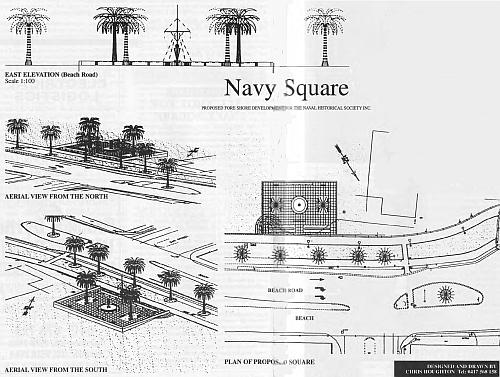- Author
- A.N. Other
- Subjects
- History - general
- Tags
-
- RAN Ships
- None noted.
- Publication
- September 1998 edition of the Naval Historical Review (all rights reserved)
The concept of a naval memorial in Port Melbourne arose in May 1997 when it was observed that following the 1994 decommissioning of HMAS Lonsdale, there was no feature in the area to recognise the long association with Navy dating back to the former Colonial Navy of 1859.
With the formation of the Sandridge and Williamstown companies of the Victorian Naval Brigade, Naval reserve training commenced in 1859 and after 1870, Victoria had a permanent Colonial Navy with drills conducted on the former Town Pier and on Sandridge Beach.
With Federation in 1901, Melbourne became the centre of the Commonwealth Administration and in 1911 the RAN was formed. The present Port Melbourne Drill Hall at the corner of Rouse and Bay Streets was built in 1912 and served as the training centre for the RANR for many years, being superseded with the commissioning of HMAS Lonsdale in 1942.
Over the years, many thousands of naval personnel passed through the area, be it in the Drill Hall or as visiting crew at Station or Princes Pier.

To recognise and preserve this heritage and working in conjunction with Navy League and the NAA, it is planned that a ‘Navy Square’ memorial be situated in the actual area where Colonial training was conducted on the beach at the intersection of Bay Street and Beach Road.
It is proposed that the centre of the Square will feature a symbolic 1.7 metre statue of a rating looking out to sea and it is envisaged that brass artifacts from former RAN vessels will be incorporated in the casting. The circular base of the statue will have a global projection highlighting the areas of the world in which the RAN served.
Angled blue stone walls will contain plaques with an educational wall illustrating in story book form, the history of Sandridge and the subsequent development of the Colonial Navy and the RAN.
Other walls will be for plaques representing naval bodies, associations, and the site will be used for memorial services.
It is our objective to have Navy Square dedicated on Australia Day, 2000.
Update
Following a- meeting between the Port Phillip Council and the Naval Historical .Society Victoria Chapter, the Council authorised the following press release on the 14th August 1998.
NEWS RELEASE
ALL AHOY FOR NAVY SQUARE
Port Phillip Council gave in principle approval this week (12/8) to a proposal from the Naval Historical Society of Australia’s Victorian Chapter to establish Navy Square on the Port Melbourne foreshore.
Port Phillip Mayor, Dick Gross, said today that Navy Square would be of symbolic and historical significance to Port Melbourne.
“It is a little known fact that Victorian Colonial Navy had its origins on a section of the Port Melbourne foreshore in 1859. This landmark event and location have been hitherto unrecognised, despite their significance to the history of the State and the nation,” he said.
Cr. Gross said that the Council warmly welcomed the Naval Historical Society’s plan to recognise the location by the construction of a paved area, to be known as Navy Square, which will be integrated into foreshore works currently underway.
“Navy Square will provide a physical focus for the recognition of naval ships and service as well as memorial events and related celebrations. Plaques associated with naval heritage – or even statues – could be mounted to tangibly identify the foundation of the Victorian Colonial Navy”, he said.
Construction is expected to be completed in time for an official opening on Australia Day, 2000.
Cr. Gross said that the full cost of the works and continuing maintenance would be met by the Naval Historical Society.
“Navy Square will be a very significant gift to the City of Port Phillip. It also highlights our crucial role in the history of our defence forces as well as enhancing the redevelopment and tourist potential of the Port Melbourne foreshore,” he said.
Final plans for the square are yet to be submitted to the Port Phillip Council. The Naval Historical Society also has a longer-term proposal for the nearby former drill hall which it will present to council at a later date.




